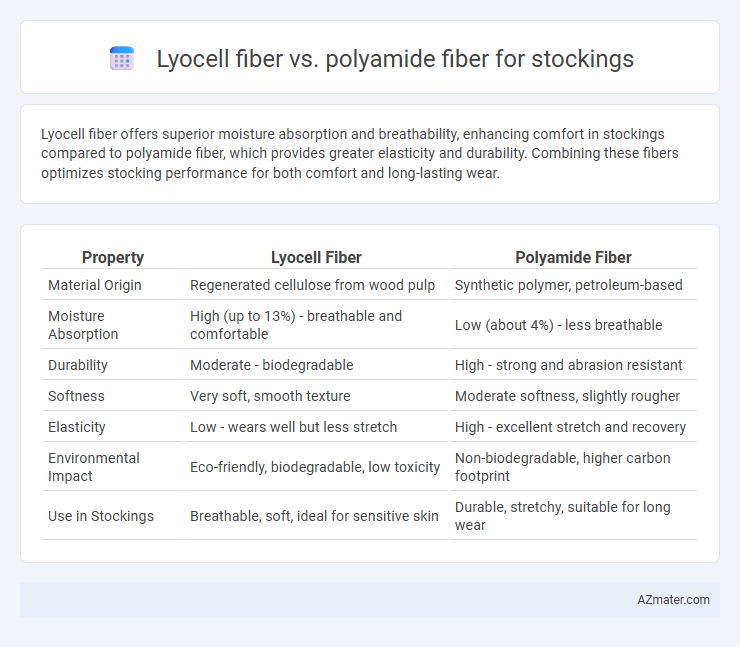Lyocell fiber offers superior moisture absorption and breathability, enhancing comfort in stockings compared to polyamide fiber, which provides greater elasticity and durability. Combining these fibers optimizes stocking performance for both comfort and long-lasting wear.
Table of Comparison
| Property | Lyocell Fiber | Polyamide Fiber |
|---|---|---|
| Material Origin | Regenerated cellulose from wood pulp | Synthetic polymer, petroleum-based |
| Moisture Absorption | High (up to 13%) - breathable and comfortable | Low (about 4%) - less breathable |
| Durability | Moderate - biodegradable | High - strong and abrasion resistant |
| Softness | Very soft, smooth texture | Moderate softness, slightly rougher |
| Elasticity | Low - wears well but less stretch | High - excellent stretch and recovery |
| Environmental Impact | Eco-friendly, biodegradable, low toxicity | Non-biodegradable, higher carbon footprint |
| Use in Stockings | Breathable, soft, ideal for sensitive skin | Durable, stretchy, suitable for long wear |
Introduction to Lyocell and Polyamide Fibers
Lyocell fiber, derived from sustainably sourced wood pulp, offers exceptional breathability, moisture-wicking, and biodegradability, making it an eco-friendly choice for stockings. Polyamide fiber, a synthetic polymer known for its strength, elasticity, and abrasion resistance, provides durability and a smooth, silky finish ideal for hosiery. Combining Lyocell's natural comfort with Polyamide's resilience enhances stocking performance and wearability.
Overview of Fiber Production Processes
Lyocell fiber is produced through a closed-loop process involving the dissolution of wood pulp in a non-toxic solvent, which is recycled with minimal environmental impact, ensuring sustainable production. Polyamide fiber, commonly known as nylon, is synthesized through the polymerization of petrochemical-derived monomers, involving energy-intensive processes with higher carbon emissions compared to Lyocell. The Lyocell process prioritizes eco-friendly and biodegradable outcomes, whereas polyamide manufacturing emphasizes durability and strength but relies on non-renewable resources.
Environmental Impact: Lyocell vs Polyamide
Lyocell fiber, derived from sustainably sourced wood pulp, offers superior biodegradability and a lower carbon footprint compared to conventional polyamide, which is petroleum-based and non-biodegradable. The closed-loop production process of Lyocell minimizes water and chemical use, resulting in reduced environmental pollution relative to the energy-intensive manufacturing of polyamide fibers. Choosing Lyocell for stockings significantly decreases microplastic pollution and supports eco-friendly textile practices.
Comfort and Softness in Stockings
Lyocell fiber offers superior moisture absorption and breathability, resulting in enhanced comfort and softness in stockings compared to polyamide fibers. The natural cellulose structure of Lyocell provides a smooth, silk-like texture that reduces irritation and promotes airflow, ideal for sensitive skin. In contrast, polyamide fibers, while durable and elastic, often lack the same level of softness and can trap heat, making them less comfortable for prolonged wear.
Breathability and Moisture Management
Lyocell fiber offers superior breathability compared to polyamide fiber due to its natural cellulose structure, which enhances air circulation and reduces heat buildup in stockings. Its excellent moisture management capabilities efficiently wick sweat away from the skin, promoting quick drying and maintaining comfort during extended wear. Polyamide fiber, while durable and elastic, tends to retain moisture and trap heat, making it less effective in breathability and moisture control for stocking applications.
Durability and Longevity of Stockings
Lyocell fiber offers excellent durability in stockings due to its strong, cellulose-based structure that resists wear and tear while maintaining breathability and softness. Polyamide fiber, commonly known as nylon, provides superior strength, elasticity, and abrasion resistance, making it highly durable and ideal for long-lasting stockings. When comparing longevity, polyamide fibers typically outperform lyocell by retaining shape and integrity over extended use and multiple washes.
Elasticity and Fit Comparison
Lyocell fiber offers superior breathability and moisture-wicking properties, contributing to a comfortable fit in stockings, whereas polyamide fiber excels in elasticity and shape retention, providing a snug and durable fit. Polyamide's high stretch recovery ensures stockings maintain their form and offer support throughout wear, while Lyocell's natural fibers provide softness but less stretch. Combining these fibers in stockings optimizes elasticity and comfort, balancing fit with skin-friendly performance.
Skin Sensitivity and Allergenicity
Lyocell fiber offers superior skin sensitivity benefits compared to polyamide fiber due to its breathable, moisture-wicking properties and hypoallergenic nature, reducing irritation and allergic reactions in stocking wearers. Polyamide fiber, while durable and elastic, can trap moisture and cause increased friction, leading to potential skin irritation and sensitivity issues, especially for individuals with sensitive skin. Choosing lyocell stockings enhances comfort and minimizes allergenicity, making it an ideal fabric for those prone to skin sensitivities.
Cost and Market Availability
Lyocell fiber, known for its eco-friendly production and moisture-wicking properties, typically incurs higher manufacturing costs compared to polyamide fiber, making it a pricier option for stocking. Polyamide fiber, widely used in the textile industry due to its durability and elasticity, benefits from established large-scale production, resulting in lower prices and greater market availability. Stocking manufacturers often prefer polyamide for cost efficiency and mass production flexibility, while lyocell appeals to niche markets prioritizing sustainability despite its limited supply.
Best Applications for Each Fiber in Stockings
Lyocell fiber offers superior moisture management and breathability, making it ideal for stockings designed for all-day comfort and sensitive skin, particularly in warm or humid climates. Polyamide fiber excels in durability and elasticity, providing excellent shape retention and resistance to wear, which suits stockings intended for active use or long-lasting wear. Choosing Lyocell supports eco-friendly and moisture-wicking stockings, while Polyamide is best for performance-oriented, resilient hosiery.

Infographic: Lyocell fiber vs Polyamide fiber for Stocking
 azmater.com
azmater.com